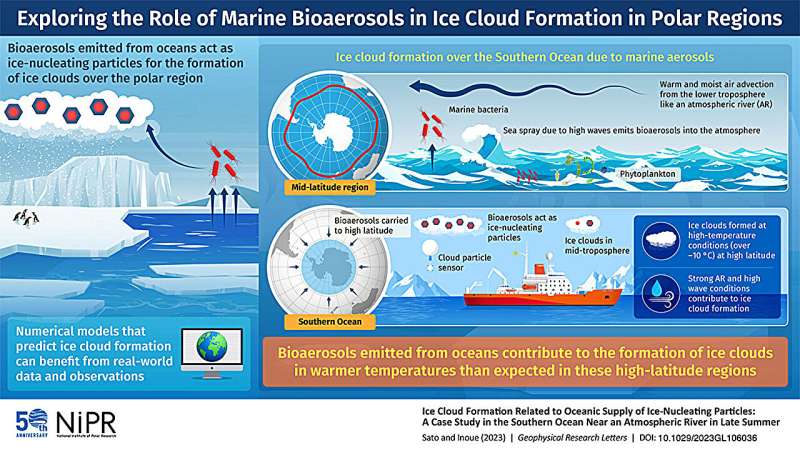
Understanding cloud formation in polar regions is essential to discern the influence of solar radiation on the polar ice caps. Existing numerical models, however, struggle to replicate ice clouds accurately. Now, using real-world observations and climate data, researchers from Japan have found that marine bioaerosols carried by streams of warm, moisture-laden air from higher latitudes contribute to the formation of ice clouds over the high latitude region of the Southern Ocean.
Clouds, which consist of tiny water droplets, ice particles, or a mix of both, are dynamic components of our planet’s climate system. They play an important role in regulating the amount of sunlight absorbed or reflected at their cloud tops. Depending on their composition, clouds form at different altitudes and exert varying effects on the climate. Understanding cloud formation in polar regions vulnerable to climate change is particularly vital. It will provide us with key information to then study their impact on ice sheets.
While numerical models have significantly advanced our ability to simulate cloud formation, they do not accurately account for how aerosol particles, which act as the starting points for the formation of ice crystals in clouds, influence the process of ice cloud formation. These biases can lead to errors in the way these models predict the behavior of ice clouds in the atmosphere.
To improve the accuracy of numerical models in representing cloud formation, Assistant Professor Kazutoshi Sato along with Jun Inoue, both from the National Institute of Polar Research, Japan, turned to real-world observations and satellite and climate data to uncover the mechanisms behind ice cloud formation in the Southern Ocean due to bioaerosols emitted from oceans.
“Developing knowledge of ice cloud formation associated with marine bioaerosols could help improve the performance of cloud phase in numerical models,” explains Dr. Inoue. Their findings have been recently published in the journal Geophysical Research Letters.
It started with an expedition to the Southern Ocean surrounding Antarctica between November 2022 and March 2023. While there, the researchers observed ice clouds forming in the mid-troposphere at temperatures above –10°C. Simultaneously, they noticed liquid water clouds in the upper troposphere at temperatures below –20°C. Typically, ice clouds form at colder temperatures, so the researchers were interested in understanding why these ice clouds appeared at milder temperatures.
Using a backward trajectory analysis, they tracked a stream of warm, moist air originating from southern Africa. Then using satellite data, the researchers found that the air mass encountered regions with a high concentration of chlorophyll-a, a pigment associated with phytoplankton, as it crossed the mid-latitude Southern Ocean. They also found that the amount of dimethylsulfide (DMS) in the air was higher in regions where there were powerful and intense waves in the water.
Why is the presence of DMS noteworthy here?
A sulfur-containing compound often linked to phytoplankton activity, DMS is recognized for its role as a nucleus in the formation of liquid water clouds. Its presence in the atmosphere also serves as an indicator of marine bacteria. These bacteria can be released into the atmosphere due to the sea spray generated by high wave conditions. According to the researchers, marine bacteria in this stream of moist warm air originating from the mid-latitude Southern Ocean act as ice nucleating particles, contributing to the formation of ice clouds at higher-than-expected temperatures over the high-latitude areas of the Southern Ocean.
“Using a cloud particle sensor sonde, we detected ice clouds at a high latitude under temperatures higher than −10°C, near a stream of warm and moist air coming from mid-latitude. These streams are often referred to as an atmospheric river (AR),” says Dr. Sato.
“The AR received marine bioaerosols from the mid-latitude ocean under high wave conditions. These bioaerosols reached the ice cloud formation layer. Our observations suggest that these marine bioaerosols, which have traveled via the AR, contribute to ice cloud formation under relatively high-temperature conditions.”
Climate models have encountered difficulties in accurately simulating ice cloud formation under higher-temperature conditions. The findings of this experimental study could enable more precise numerical modeling of climate conditions, especially in vulnerable polar areas.
More information:
Kazutoshi Sato et al, Ice Cloud Formation Related to Oceanic Supply of Ice‐Nucleating Particles: A Case Study in the Southern Ocean Near an Atmospheric River in Late Summer, Geophysical Research Letters (2023). DOI: 10.1029/2023GL106036
Journal information:
Geophysical Research Letters
Provided by
National Institute of Polar Research
Research finds marine bacteria, atmospheric rivers can contribute to formation of ice clouds (2023, December 8)
retrieved 9 December 2023
from https://phys.org/news/2023-12-marine-bacteria-atmospheric-rivers-contribute.html
part may be reproduced without the written permission. The content is provided for information purposes only.